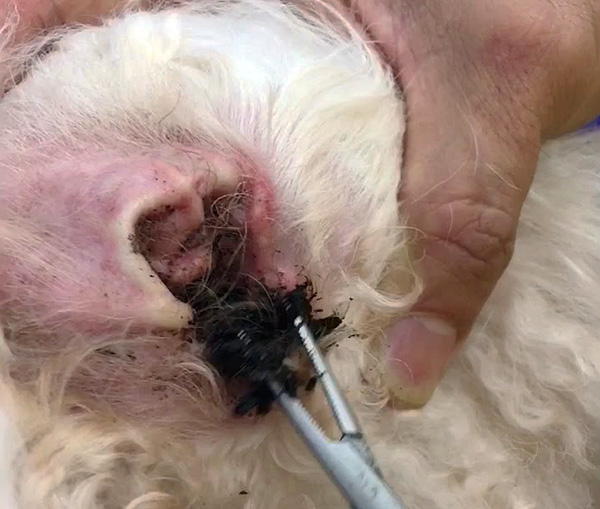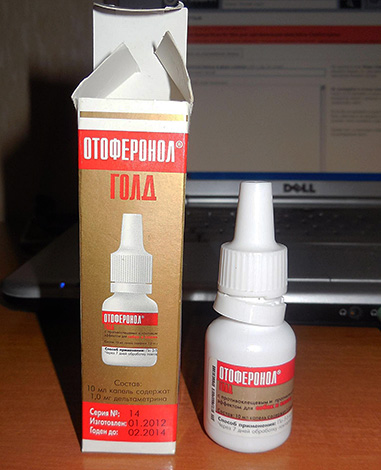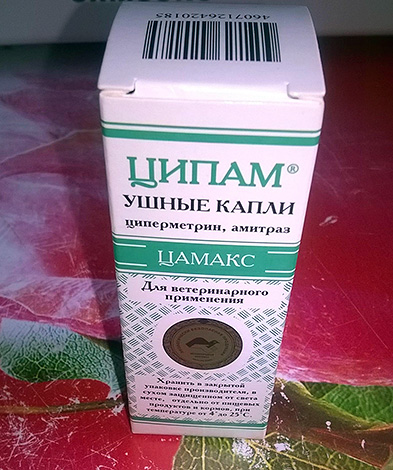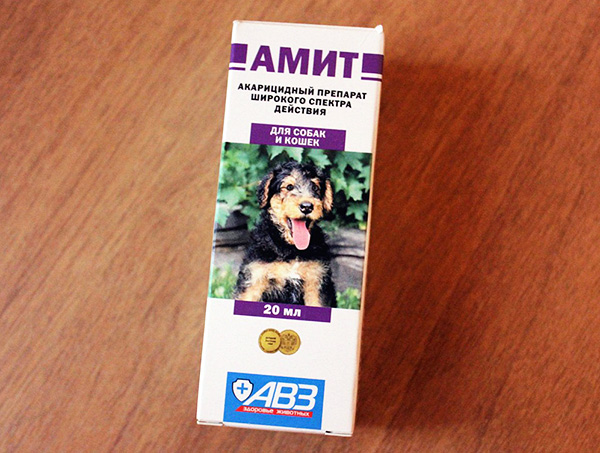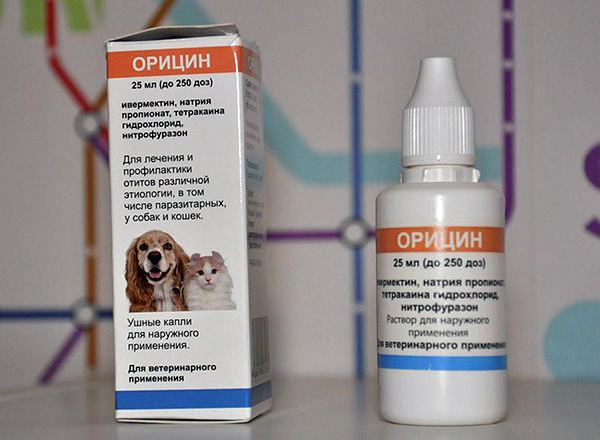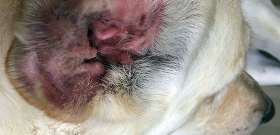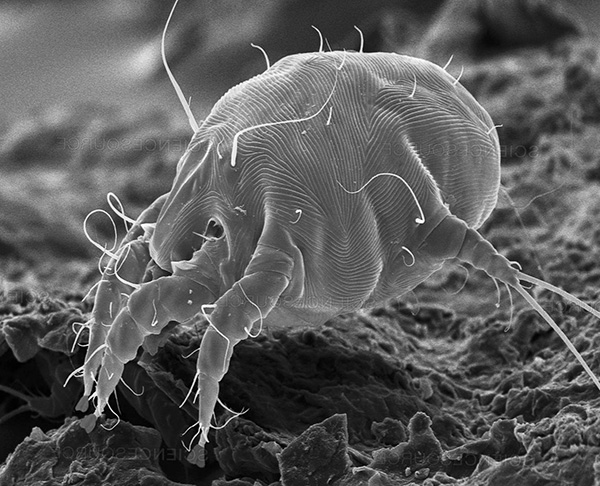
Ear mites are dangerous parasites of cats, dogs, rabbits, pigs and other animals (including wild ones), causing them a disease called ear scabies (otherwise - otodectosis). This disease spreads very quickly, and is the second most common among domestic animals (the primacy among external parasites belongs to fleas).
Ear mites parasitize on the surface of the skin in the external auditory canal of the host. In humans, these arthropods, as permanent parasites, are rare: only a few cases of human infection with otodectosis have been described in detail (more on this will be discussed below).
However, rabbits, cats and dogs are highly susceptible to the negative effects of these mites. Young animals grow poorly, feed and gain weight, are restless, comb their ears until ulcers form. They do not sleep, constantly keep their heads tilted. With the further development of the disease, hearing deteriorates, acute otitis occurs.
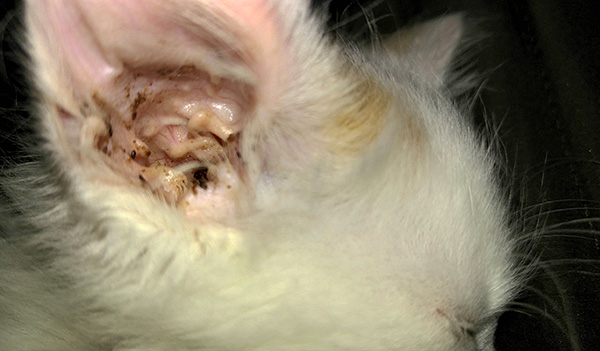
If the disease is started, severe inflammation develops, which can lead to meningitis and death of the animal. Treatment is complicated by the fact that in the place where the tick is located, a breeding ground of associated microorganisms is formed, which further weaken the pet's body.
Let's see how the ear mite looks and breeds, where it lives and how the parasite infects domestic animals, and also see if it is dangerous for humans and what to do if the animal has already become infected and suffers from otodectosis ...
Features of vital activity and appearance of parasites
Ear scabies of animals is caused by several species of Akarimorph mites from the Psoroptidae family. These parasites are very selective in choosing a host, so each type of tick can live only on a specific host, and when it hits a “not its own” species, it dies.
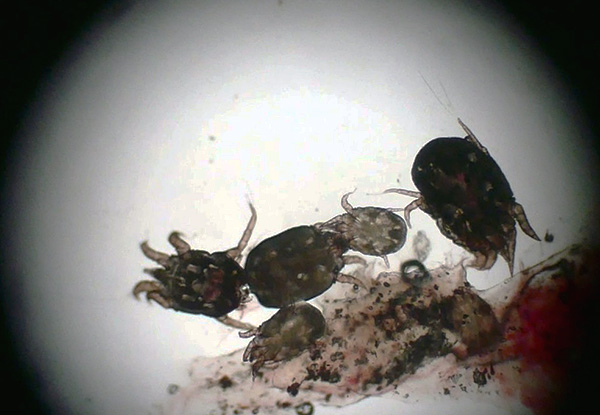
On a note
On predatory animals, in particular dogs and cats, the mite Otodectes cynotis parasitizes, therefore the disease is called otodectosis (from the generic name of the parasite). But in rabbits and sheep, another arthropod belonging to the genus Psoroptes lives in the ears, so the ear scabies of these mammals is called psoroptosis. Symptoms of the disease caused by these parasites are very similar, but there are some nuances. For example, psoroptosis never occurs in humans, while human cases of otodectosis have been reported.
Ear mites are very small parasites that are quite difficult to see with the naked eye. The size of females is only 0.5 mm, while males are half as large. The body of ear mites is broadly oval, slightly colored, sometimes red, yellow or light brown.
The photo below shows what an adult ear mite looks like:
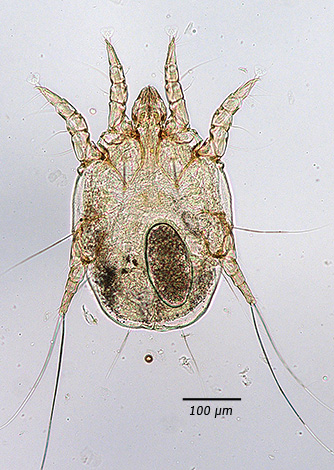
Males differ from females in the presence of two scutes on the ventral side. 4 pairs of powerful thick legs depart from the body, which adhere well to the epidermis of the host's skin.In otodex 4, the pair of legs is reduced, so they are easily identified in the laboratory diagnosis of the disease.
The oral apparatus of the sucking type. Powerful chelicerae cut the delicate thin skin of the auditory canal, after which the parasite begins to feed on lymph, blood from the capillaries, and a little later - the liquid from the focus of inflammation.
The life cycle of ear parasites follows a common scenario for all mites and consists of five stages:
- Eggs;
- Larvae;
- Two nymphs (proto- and teleonymphs);
- Adult individual (imago).
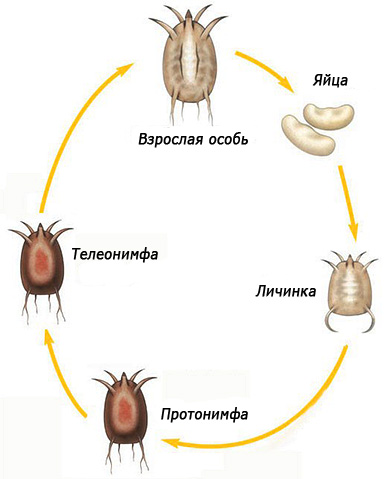
Both sexually mature individuals and larvae and nymphs actively feed, and if they get on other animals, they can infect them. All stages of the tick's life cycle are invasive - from egg to larva, that is, infection occurs regardless of whether eggs or an adult have got on the pet's coat.
The development of ear mites occurs very quickly - these parasites need no more than 10 days to complete the cycle. In the external environment, arthropods survive up to 20 days, after which, if they do not find a host, they die. At the same time, not a single stage of the life cycle passes outside the host: unlike ixodid, ear mites are permanent parasites that must always be in the ears of the host (less often on the body).
In the photo - ticks Otodectes Cynotis in the ear canal of a cat:

On a note
Fertilization in ear mites occurs in two stages. First, a sexually mature male finds a female nymph and injects a spermatophore (a capsule with spermatozoa) into her genital ducts. The nymph molts into a sexually mature female, and only after that does the very moment of fertilization occur.
Females are very fertile, and under favorable conditions they lay hundreds of eggs, which are located both in the ears and on them. At high concentrations, the eggs are dispersed throughout the body of the animal, along the litter and the apartment. After a short period of time, all surrounding objects become potential sources of infection, therefore they are dangerous not only for other animals living in the house, but also for humans.
Ear mites in humans
Most specialized literature states that ear mites do not parasitize humans, even if their pets are carriers of these parasites. In most cases, this is true - these parasites do not pose a serious danger to humans.
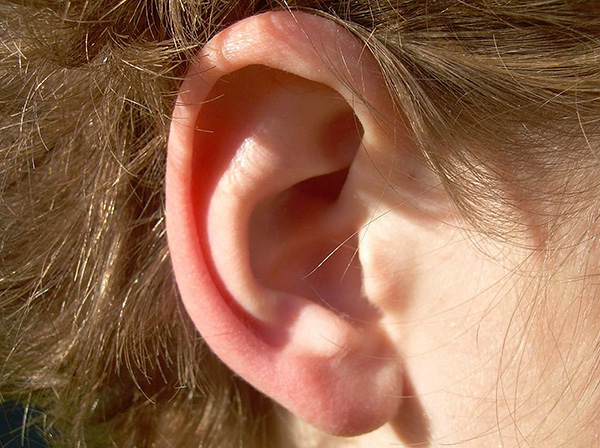
However, cases of infection with human ear mites from pets are known. One of the most famous cases is that of a Belgian woman. Sources say that this woman lived in a small town and was the wife of a farmer, so she was constantly in contact with various pets.
Initially, the victim went to the doctor with complaints of acute otitis media. After some time, adults and larvae of the tick Otodectes cynotis were removed from her ear.
It is interesting
Another case was recorded in California. A certain lady went to the hospital with complaints of itching in the chest, arms and legs, which she had after purchasing a Cocker Spaniel. It turned out that the dog was infected, and otodectosis mites from her ear canals crawled onto the woman, having adapted to parasitizing on other parts of the body.
However, such cases are rather an exception to the rule than the norm: the reasons for the appearance of ear mites in humans are not completely clear.Due to the fact that these parasites are very picky in choosing a host and need certain microclimatic conditions, as well as the unchanged chemical composition of the food consumed, death of ticks is observed in 99.9% of cases when it enters an individual of another species.
On a note
There is another important point to consider: in the process of life, ticks release active chemicals that are strong allergens. They accumulate in large quantities in the auricle of the host, and the animal, when scratching and cleansing, smears them all over its body. When a person then picks up or strokes their pet, these substances get on the skin and can cause allergic itching and irritation.
In addition to the "classic" ear mites, a person can also parasitize in the ear canal:
- ixodid ticks;
- Argas mites;
- Ticks of the genus Demodex that cause demodicosis.
Representatives of the first two groups are external parasites and feed on blood, adhering to the surface of the body in any part of it, including crawling into the auricle. However, their parasitism is short-lived - as soon as the mites are fed, they leave the host and enter the external environment, where their further development takes place.
Demodicosis is a disease of the skin in general. Ticks develop in the layers of the skin and skin glands, which can cause red acne to appear on the face and body. The same thing happens with the skin of the auricle.
Signs of infestation with these mites differ significantly from an infestation with an ear mite.There is redness and pain inside the ear, but there is no discharge of a large amount of sulfur and lymph, as well as the appearance of scabs in the ear canal.
Returning to ear mites, it is worth noting that, despite the low degree of their danger to humans, animals can suffer greatly from otodectosis. Let's take a look at how pets become infected...
How infection occurs
The greatest danger as a source of infection are stray cats and dogs. After contact with them, eggs, larvae and adults of the parasite remain on human skin and animal fur. Next, arachnids enter the external auditory canal, where they begin to actively feed and multiply.

Also, infection can occur through various objects, such as furniture in an apartment with a sick animal, care items: combs, various rugs, toys, food containers.
Animals are most often ill in places of their mass keeping, characterized by poor sanitary conditions. The tick is transmitted especially quickly in rooms with a humid and warm microclimate. When combing the affected areas with animals, the mites, together with exfoliated pieces of the epidermis, scatter over considerable distances and settle on all surrounding objects, therefore, in addition to treating a sick animal, special treatment of a private house or apartment is also necessary.

Without food sources, ear mites live for more than two weeks in the environment.
In view of the foregoing, the following main ways of infection with otodectosis can be distinguished:
- Domestic animals become infected from wild or stray animals during walks, when sniffing and examining adjacent territories;
- Through care items, when several animals are cared for with the same tools;
- Through cages, transportation devices, toys, collars and leashes;
- The parasite can be transmitted from a person who is a carrier (for example, you stroked a stray dog, and then, without washing your hands, you started playing with your pet);
- A person can become infected only after contact with a sick animal, but in most cases people can only act as carriers of an ear mite, and they themselves do not suffer from otodectosis.
Interesting facts about ear mites
Otodectosis is widespread in all European countries. A significant proportion of wild fur animals in America and Canada suffer from this disease. In Russia, otodectosis is most common in the Leningrad, Voronezh and Kaliningrad regions, as well as in Karelia.
Cats and dogs are equally affected by the parasite, with animals over 6 months of age most often affected (but younger age groups are also susceptible to infection).
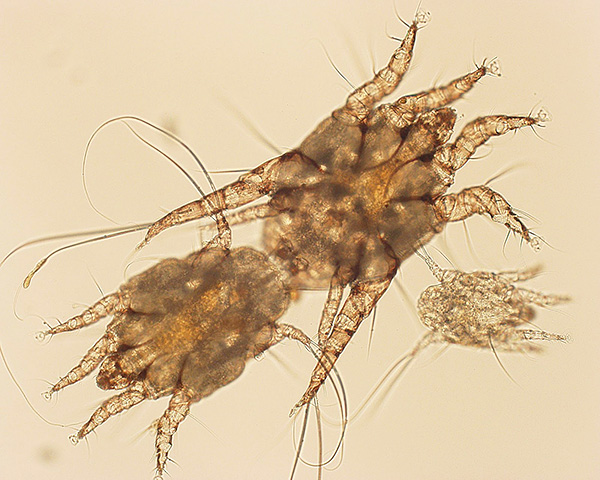
Animals prone to the development of otitis are especially sensitive. Some experts believe that ear mites are most common in long-eared dogs, and the risk group includes:
- French bulldogs;
- Cocker spaniels;
- Poodles;
- German Shepherds.
As for cats, both purebred and outbred animals suffer almost equally. Although, according to some reports, ear mite infection is most severe in Maine Coons, Persian and Siamese cats.
Rabbits, pigs, guinea pigs, ferrets are also often susceptible to otodectosis.
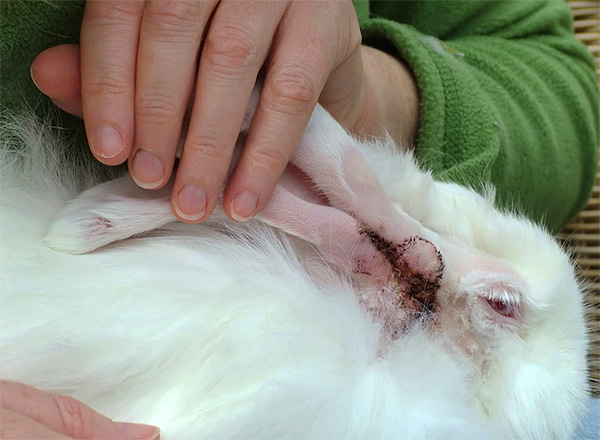
The disease does not have a seasonal confinement: infection can occur at any time of the year, since the parasites live in a protected environment (in the ear canal), where a microclimate favorable for reproduction is created for them. However, the peak of activity is still observed in winter - in January and February - while the summer dry months are characterized by a slight decrease in the number of diseases.
Symptoms of otodectosis
Otodectosis is a chronic parasitic disease that can last for a considerable period of time and eventually lead to the death of the animal.
In sick animals, severe swelling of the ear canals is observed - discharge from damaged skin, mixing with earwax, epidermal particles and waste products of ticks, forms a dark brown mass, which forms a plug in the ear canal.
In the chronic course of the disease, an accompanying microflora settles in the place of tick parasitism, which increases suppuration - the process spreads to the middle and inner ear, after which the meninges are affected, and the animal dies.
As noted above, ear mites feed on lymph, blood, and products of inflammatory reactions in tissues. During such parasitism, skin receptors are constantly irritated, which causes severe itching in the ears, as well as pain in the animal.
On a note
Against the background of the inflammatory process in the ear, a general intoxication of the body is observed. Because of this, the animal feels unwell, becomes lethargic, and the temperature can rise greatly.
The most characteristic sign by which an ear mite infection can be recognized is abundant discharge from the ears, which looks like brown flakes with an unpleasant odor. It is extremely difficult not to notice such a symptom, however, in the early stages of the introduction of the tick, only severe itching is felt in the ear canal.

Accordingly, in addition to brown discharge from the ears, the following symptoms of otodectosis appear in animals:
- Constant scratching of the ears and head space near the auricles, due to severe itching from tick parasitism. Because of this, the animal often shakes its head;
- Restlessness, lack of sleep and appetite - animals do not eat well and gain weight, their hair falls out;
- Sometimes the disease proceeds in the form of purulent otitis media - then, due to severe pain, the animals constantly make plaintive sounds and frantically try to clean the auricle;
- Often in infected animals, “crooked head” is observed - due to itching and pain, the pet keeps its head tilted.
The auditory canal of sick cats and dogs is often filled with secretions that look like coffee grounds. The ear is red, inflamed and painful, and with intense scratching, hematomas appear on the muzzle. Often there is an increase in lymph nodes associated with the course of an inflammatory reaction.
Even if only one ear is initially affected, when scratching, the parasite is inevitably transferred to the other. With mass reproduction of the parasite, its eggs, larvae and nymphs spread throughout the body of the animal. In close contact with other animals, the carrier will certainly infect them.
On a note
Sometimes the breeding site of the parasite is not limited to the ears. Feeding of ticks can also be observed on the neck, rump and tail. The parasitism of the otodect mite in the back of the body of cats is possible due to the habits of these animals to sleep in a ball.
The most reliable way to determine whether a cat or dog is infected with ear mites is through laboratory diagnostics. To do this, specialists take a sample of secretions on a cotton swab from the pet's ear canals. When examining a sample among the scales of the epithelium under a microscope, ear mites are usually clearly visible.
In the photograph below, under a microscope, ear mites are visible in the test sample:

If infection is confirmed, treatment should be started immediately.
Ear mites treatment
We note right away that it will not work to pull out all the ticks with an ear stick moistened with water (in practice, people often try to do this). It is precisely drug treatment that is necessary, since there are usually a lot of parasites and they are introduced under the skin scales, which makes it impossible to get them all.
At the same time, it should be taken into account that earwax and products of the inflammatory reaction form plugs that prevent the penetration of topical drugs into the focus of the disease. Therefore, the first step is to clean the ear canal - for this they usually use a solution of chlorhexidine, or Otodin, Otifri or Beafar lotions.


These liquids are poured directly into the ear. After that, you can lightly massage the auricle to increase the rate of softening of the secretions (if this causes pain in the animal, you need to massage very carefully).
On a note
Some people try to pour hydrogen peroxide into a sore pet's ear, knowing that it well dilutes sulfuric plugs. But with severe inflammation for the animal, this can be very painful, so it is not recommended to do this.
After softening the masses polluting the ears, they should be removed with a cotton swab or gauze.
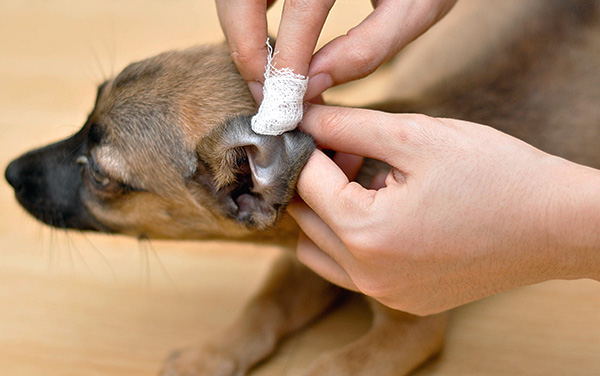
Then proceed directly to drug treatment. As acaricides in veterinary medicine, pyrethroids and organophosphorus compounds are usually used in the form of ear drops and ointments (gels).
However, here it is important to take into account some nuances before using this or that tool:
- Drops from fleas and ticks Stronghold: these are drops from ixodid ticks (that is, from forest ones), and not from ear ones, and they are buried at the withers, and in no case in the ears. So, in the fight against otodectosis, they can provide only a weak preventive effect. The same goes for the popular Frontline drops. Attempts to put these drops in the ears carry the risk of causing significant harm to the health of the pet (depending on individual sensitivity);
- Bars ear drops are a good option. It is important not to confuse this drug with drops on the withers Bars from fleas and ticks;

- Otoferonol Plus, Premium and Gold are good specialized drugs that help get rid of ear mites;

- Tsipam - ear drops based on cypermethrin and amitraz. Also a normal option;

- Decor-2 - acaricidal drops based on permethrin for the treatment and prevention of otodectosis. An acceptable option, however, it should be borne in mind that the concentration of permethrin in the composition is quite high (10%), and for cats, unlike dogs, this substance has increased toxicity;

- Ear drops Amit based on amitraz is a normal option;

- Oricin - ear drops based on lindane, which has a pronounced acaricidal effect. They may also be suitable for treatment (if there are no contraindications).

All of the above drugs should be used strictly according to the instructions and only after consulting a veterinarian.The price is different for everyone, but this does not mean that a more expensive remedy will be the most effective and safe.
On a note
Some reviews indicate that solutions of neocidol, cyodrine, etafos, sumicidin or creoquine can also help get rid of ear mites. These drugs are very active: it is enough to apply these drugs twice into the pet's auricle to reliably get rid of ear parasites.
There is also evidence that neo-stomazan and butox solutions help to remove ear mites well - they are also applied 2 times with a week break. But when treating with such drugs, it should be remembered that a pet may experience hypersensitivity to them, and then the remedy can lead to severe allergic reactions.
As part of complex therapy, the use of various ointments and gels gives good results, since they not only allow you to destroy the ear mites, but also have analgesic and moisturizing effects.
For example, the Ivermek-gel remedy is popular - it has a pronounced acaricidal effect, and lidocaine, which is part of it, reduces the intensity of itching after half an hour.
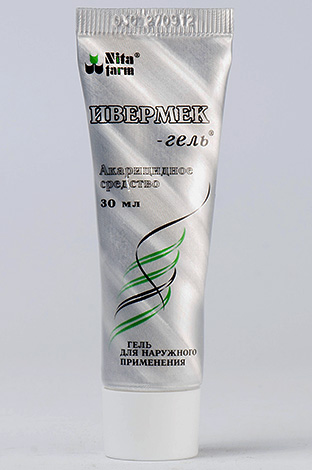
Unfortunately, the disease is often complicated by concomitant microflora. In this case, it is usually necessary to use antibacterial drugs, and not just acaricides. In this case, there are complex preparations: Demos, Dekta, Aurikan, etc., which have not only anti-tick, but also antimicrobial and anti-allergenic components.
In any case, in order to achieve a good result in treatment, it is necessary to constantly consult with a specialist and strictly follow the instructions for using a particular drug.Doing home treatment or using traditional methods is not worth it, as this can harm your pet's health and slow down recovery.
Prevention measures
Prevention of infection with otodectosis of people and domestic animals consists mainly in preventing contact with sick animals, which, most often, are stray cats and dogs. If there are several pets in the house and one of them has become infected, do not even doubt that everyone will need treatment soon.

On a note
Although cases of human infection with otodectosis are rare, there is still no guarantee of complete safety from these parasites. It should also be remembered about the negative impact of the waste products of ear mites on human skin (allergic sensitization is possible).
Even if a person does not suffer from otodectosis, he can be a carrier of ear mites, so personal hygiene must be monitored as carefully as the hygiene of pets.
In addition to treating sick animals, it is necessary to carry out thorough disinfection in the apartment and cages - more precisely, acaricidal treatment (this can be done either on your own or contact the pest control service, which are many in any large city today).

In addition, ticks quickly die from direct sunlight and insufficient humidity, so it is recommended to regularly ventilate the apartment and, if necessary, “fry” the furniture in the sun.
Hot water also has a negative effect on parasites, so it is advisable to boil linen, bedding and various tissues with which a sick animal has come into contact.Cells are treated with acaricidal preparations (generally speaking, almost any insecticidal agent can be used for this purpose, including Dichlorvos, Raptor, Raid aerosols, or concentrates for dilution and spraying in the form of a spray Get, Hangman, Xulat Micro, etc.). In the apartment, in addition to cleaning upholstered furniture, you need to carry out a general cleaning: thoroughly wash all surfaces with detergent.
If you have personal experience in treating an animal for ear mites, be sure to leave your review at the bottom of this page. Whether you were able to cope with the problem, what tool you used, whether you quickly managed to achieve the desired result - readers will be interested in any information.
A good example of otodectosis in humans


